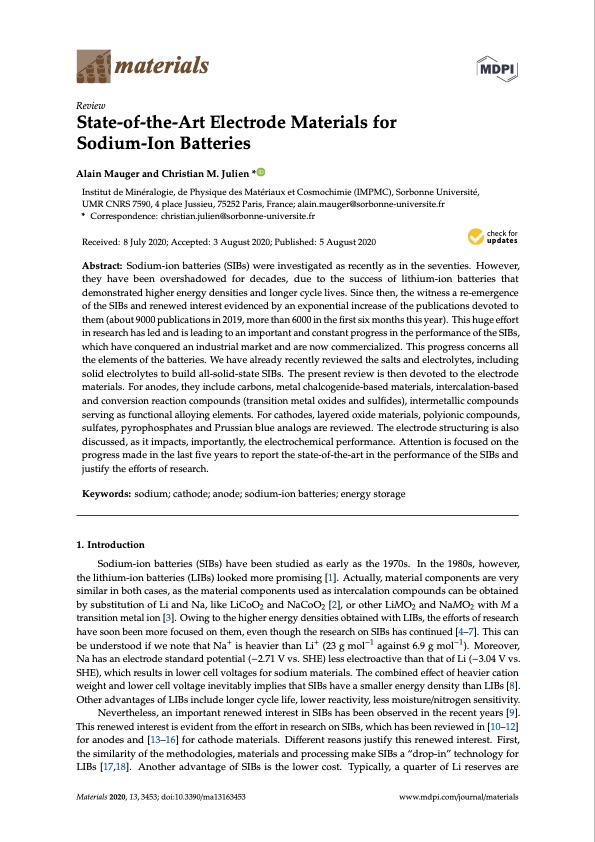
PDF Publication Title:
Text from PDF Page: 001
materials Review State-of-the-Art Electrode Materials for Sodium-Ion Batteries Alain Mauger and Christian M. Julien * Institut de Minéralogie, de Physique des Matériaux et Cosmochimie (IMPMC), Sorbonne Université, UMR CNRS 7590, 4 place Jussieu, 75252 Paris, France; alain.mauger@sorbonne-universite.fr * Correspondence: christian.julien@sorbonne-universite.fr Received: 8 July 2020; Accepted: 3 August 2020; Published: 5 August 2020 Abstract: Sodium-ion batteries (SIBs) were investigated as recently as in the seventies. However, they have been overshadowed for decades, due to the success of lithium-ion batteries that demonstrated higher energy densities and longer cycle lives. Since then, the witness a re-emergence of the SIBs and renewed interest evidenced by an exponential increase of the publications devoted to them (about 9000 publications in 2019, more than 6000 in the first six months this year). This huge effort in research has led and is leading to an important and constant progress in the performance of the SIBs, which have conquered an industrial market and are now commercialized. This progress concerns all the elements of the batteries. We have already recently reviewed the salts and electrolytes, including solid electrolytes to build all-solid-state SIBs. The present review is then devoted to the electrode materials. For anodes, they include carbons, metal chalcogenide-based materials, intercalation-based and conversion reaction compounds (transition metal oxides and sulfides), intermetallic compounds serving as functional alloying elements. For cathodes, layered oxide materials, polyionic compounds, sulfates, pyrophosphates and Prussian blue analogs are reviewed. The electrode structuring is also discussed, as it impacts, importantly, the electrochemical performance. Attention is focused on the progress made in the last five years to report the state-of-the-art in the performance of the SIBs and justify the efforts of research. Keywords: sodium; cathode; anode; sodium-ion batteries; energy storage 1. Introduction Sodium-ion batteries (SIBs) have been studied as early as the 1970s. In the 1980s, however, the lithium-ion batteries (LIBs) looked more promising [1]. Actually, material components are very similar in both cases, as the material components used as intercalation compounds can be obtained by substitution of Li and Na, like LiCoO2 and NaCoO2 [2], or other LiMO2 and NaMO2 with M a transition metal ion [3]. Owing to the higher energy densities obtained with LIBs, the efforts of research have soon been more focused on them, even though the research on SIBs has continued [4–7]. This can be understood if we note that Na+ is heavier than Li+ (23 g mol−1 against 6.9 g mol−1). Moreover, Na has an electrode standard potential (−2.71 V vs. SHE) less electroactive than that of Li (−3.04 V vs. SHE), which results in lower cell voltages for sodium materials. The combined effect of heavier cation weight and lower cell voltage inevitably implies that SIBs have a smaller energy density than LIBs [8]. Other advantages of LIBs include longer cycle life, lower reactivity, less moisture/nitrogen sensitivity. Nevertheless, an important renewed interest in SIBs has been observed in the recent years [9]. This renewed interest is evident from the effort in research on SIBs, which has been reviewed in [10–12] for anodes and [13–16] for cathode materials. Different reasons justify this renewed interest. First, the similarity of the methodologies, materials and processing make SIBs a “drop-in” technology for LIBs [17,18]. Another advantage of SIBs is the lower cost. Typically, a quarter of Li reserves are Materials 2020, 13, 3453; doi:10.3390/ma13163453 www.mdpi.com/journal/materialsPDF Image | Electrode Materials for Sodium-Ion Batteries

PDF Search Title:
Electrode Materials for Sodium-Ion BatteriesOriginal File Name Searched:
materials-13-03453-v2.pdfDIY PDF Search: Google It | Yahoo | Bing
Salgenx Redox Flow Battery Technology: Salt water flow battery technology with low cost and great energy density that can be used for power storage and thermal storage. Let us de-risk your production using our license. Our aqueous flow battery is less cost than Tesla Megapack and available faster. Redox flow battery. No membrane needed like with Vanadium, or Bromine. Salgenx flow battery
| CONTACT TEL: 608-238-6001 Email: greg@salgenx.com | RSS | AMP |